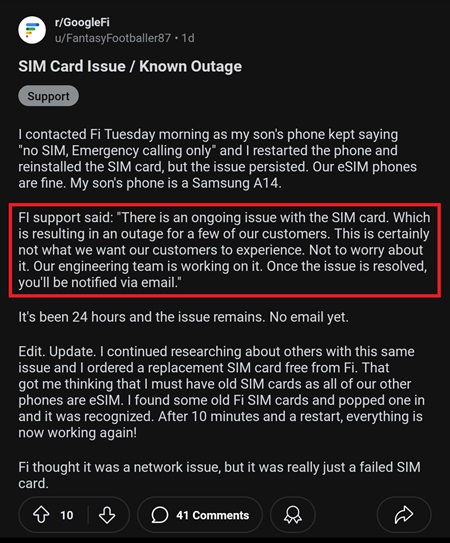Update 24/10/24 10:50 am (IST): Google has finally admitted that a manufacturing defect is the reason why some SIM cards are failing. As highlighted by 9to5Google, the company is sending out emails to users saying it “recently discovered that certain SIM cards have been failing due to a manufacturing issue.” One Redditor also claims that they received a $60 credit to their account for the hassle. The email recommends users upgrade “to a new SIM to avoid an unexpected failure.”
Update 21/06/24 11:25 am (IST): Last week, a product expert in the Google Fi forum hinted that the issue has been escalated for further investigation. And a couple of days ago, a Redditor shared that Fi support told them the issue is known, and the engineering team is working on a fix. However, there’s still no public statement from Fi regarding this matter.

Original article from June 6 follows:
Over the past few weeks, Google Fi users have been grappling with an annoying issue: the sudden failure of physical SIM cards. Reports of sudden loss of service are rampant, with phones displaying “No SIM” or “Emergency Calls Only” errors, leaving users stranded without a working phone. This issue has sparked numerous discussions on Reddit and Google Fi forums, revealing a widespread problem that Google has yet to address publicly. Considering the importance of having a working SIM card, I find this situation alarming and perplexing, and it’s about time we dig a little deeper into what’s going on.
The scale of the Google Fi physical SIM problem
The core issue is straightforward: physical SIM cards on Google Fi are failing. One of the most striking aspects of this issue is the sheer volume and variety of user reports. For instance, a user reported that their SIM card, which had been functioning perfectly for months, suddenly stopped working. Despite trying the SIM card in multiple phones and even obtaining a new SIM card, the issue persisted, leading them to consider switching to an eSIM. Another user faced a similar problem with their child’s phone, where multiple SIM cards failed within a short span, forcing them to rely on eSIM despite preferring physical SIMs.
These experiences are not isolated. Many users have recounted tales of SIM cards that worked fine initially but later failed, often without any apparent reason. Some users have even experienced repeated failures across multiple SIM cards and phones, adding to the confusion and frustration. The common thread in these stories is the sudden loss of service, with phones displaying messages like “No SIM,” “No Service,” or “Google Fi is not fully activated.”
This inconsistency adds to the frustration, as the problem doesn’t seem tied to a specific phone model or age. Users across the spectrum, from Samsung and Pixel owners to iPhone users, have reported similar problems. This suggests a systemic issue with Fi SIM cards rather than an isolated hardware or software glitch. Furthermore, the problem isn’t limited to new users or recently activated SIM cards. Several users have reported their SIM cards failing after years of flawless service, indicating a potential change in Google Fi’s network or a defective batch of SIM cards.
It’s baffling and frustrating that such a critical component of the service could fail so frequently and unpredictably. It makes one question how such an issue would slip through the quality control processes in place for these SIM cards.

Why are physical SIM cards suddenly not working on Google Fi?
Adding to the frustration, some users claim that Google Fi customer support has been unhelpful, offering generic troubleshooting advice or simply telling them to wait for an unspecified fix. With the cause of this widespread physical SIM card failure still a mystery, several theories have emerged.
A defective batch of SIM cards
One popular theory suggests that the issue might be related to a defective batch of SIM cards. Users have reported that Google Fi pulled SIM cards from 3rd-party stores like Best Buy and Target a few weeks ago, which could indicate a recall of faulty SIMs. However, this theory does not explain why some users continue to experience issues even after replacing their SIM cards with new ones shipped directly from Google Fi.
A software glitch
Another theory points to potential software or firmware issues. It’s possible that a recent update to the Google Fi app or the network itself might be causing physical SIM cards to fail. One user noted that their SIM card failures coincided with a software update, suggesting a possible link. This theory is further supported by the fact that many users have reported that their SIM cards worked fine until a certain point, after which they suddenly stopped functioning.
Google Fi phasing out physical SIM cards
There is also speculation that Google might be intentionally phasing out physical SIM cards in favor of eSIM technology. While this theory might sound like a conspiracy, it gains some credibility from the fact that several users have reported being advised by Google Fi support to switch to eSIM. Furthermore, Apple has slowly started replacing SIM card slots with eSIM on its latest devices, something that’s largely affected Google Fi data-only plans on the 2014 iPads. However, this theory is not entirely convincing, as Google Fi still sells phones that do not support eSIM, and the company has not made any public statements indicating a shift away from physical SIMs.
Even if it were true, the push towards eSIM may feel somewhat coercive for those who prefer the simplicity and flexibility of physical SIM cards. The convenience of swapping SIMs between devices without dealing with digital transfers is something some still value highly, and they may not be ready to let go of that.
Missing SIM cards and Google Fi support woes
Another layer to this issue is the apparent scarcity of Google Fi SIM cards in retail stores. Several users have reported being unable to find SIM card kits at stores like Best Buy, Target, and Amazon. This has compounded the frustration for users who need a replacement SIM quickly but are forced to wait for one to be shipped from Google.
The response from Google Fi support has been mixed. Some users have praised the support team for their efforts, while others have found the experience lacking. There are reports of support agents suggesting users switch to eSIM or offering reimbursement for retail purchases of SIM cards. Others report being told that the problem is known and that engineers are working on it, yet no concrete solutions have been provided. Regardless, these solutions have not been satisfactory for many, especially those who rely on their phones for essential communication or business.
Sure, the scarcity of physical SIM cards could suggest one of a couple of things. Either a supply chain issue or a strategic move by Google to limit physical SIM availability. If it’s the latter, it could be a troubling sign that Google is nudging users towards eSIMs, possibly due to lower costs or other operational advantages. As for Google’s response, this level of support is unacceptable. It feels like Google is not taking the issue seriously enough, and their responses are more about placating users than solving the problem. The lack of transparency and effective communication only adds to the frustration.
Broader implications for the future of physical SIM cards
The ongoing issues with Google Fi physical SIM card not working raise broader questions about the future of SIM technology in the United States. With the recent launch of the iPhone 15 and 2024 iPads, which replaces physical SIMs with eSIMs, it’s clear that the industry is moving towards a more digital approach to mobile connectivity. eSIM technology offers several advantages, including easier activation, the ability to switch carriers without needing a new SIM card, and improved security.

However, the transition to eSIM is not without its challenges. Not all phones currently support eSIM, and many users still prefer the simplicity and familiarity of physical SIM cards. The issues faced by Google Fi users highlight the potential pitfalls of this transition, especially if hardware, software, or support systems are not adequately prepared to handle the shift.
Some of you might not be old enough to remember the microSD card slot. While some phones still have the slot, it’s one of the rarest features you’ll find on any flagship phone today. And I’m afraid the physical SIM card slot may soon become obsolete, just like the microSD card slot.
What can you do to fix physical SIM card issues on Fi?
While the root cause of these SIM card failures remains unclear, some users have found temporary solutions. Although they may not offer a quick fix, it’s important to report the issue to Google Fi support so they can track the scale of the problem. Switching to eSIM, as suggested by support, has also worked for several users, though it is not an option for everyone. Others have resorted to getting new SIM cards, sometimes multiple times, to restore service. If you’re fed up with Google Fi’s response, you might want to explore other carriers.
The experiences of Google Fi users with failing physical SIM cards reflect a complex and multifaceted issue. Whether the root cause lies in defective hardware, software updates, or a broader industry shift towards eSIM technology, the impact on users has been significant and often frustrating. Google Fi’s support response, while varied, suggests an ongoing struggle to address the issue effectively.
I hope the company will take these concerns seriously and provide a robust solution soon. The move towards eSIMs might be inevitable, but it should not come at the cost of current service quality. Until then, sharing experiences and staying informed is crucial for those affected by this issue.
In the meantime, if you’re dealing with a failing SIM card, my advice is to push Google Fi support for a more permanent solution and to consider switching to eSIM if your device supports it. It’s not the perfect answer, but it might be the best one available for now.
TechIssuesToday primarily focuses on publishing 'breaking' or 'exclusive' tech news. This means, we are usually the first news website on the whole Internet to highlight the topics we cover daily. So far, our stories have been picked up by many mainstream technology publications like The Verge, Macrumors, Forbes, etc. To know more, head here.

![[Updated] Google Fi physical SIM cards are failing for some users - but why? [Updated] Google Fi physical SIM cards are failing for some users - but why?](https://techissuestoday.com/wp-content/uploads/2024/06/Google-Fi-SIM-card.jpg)
